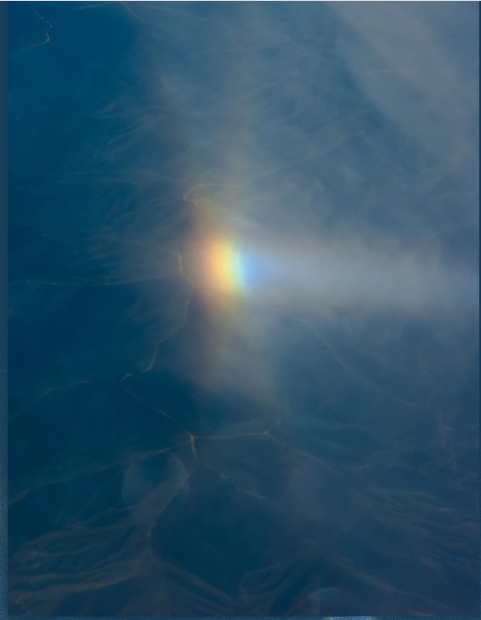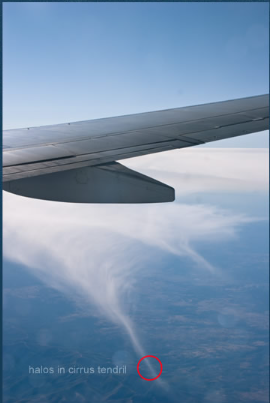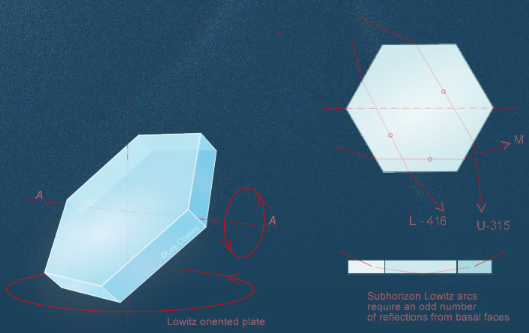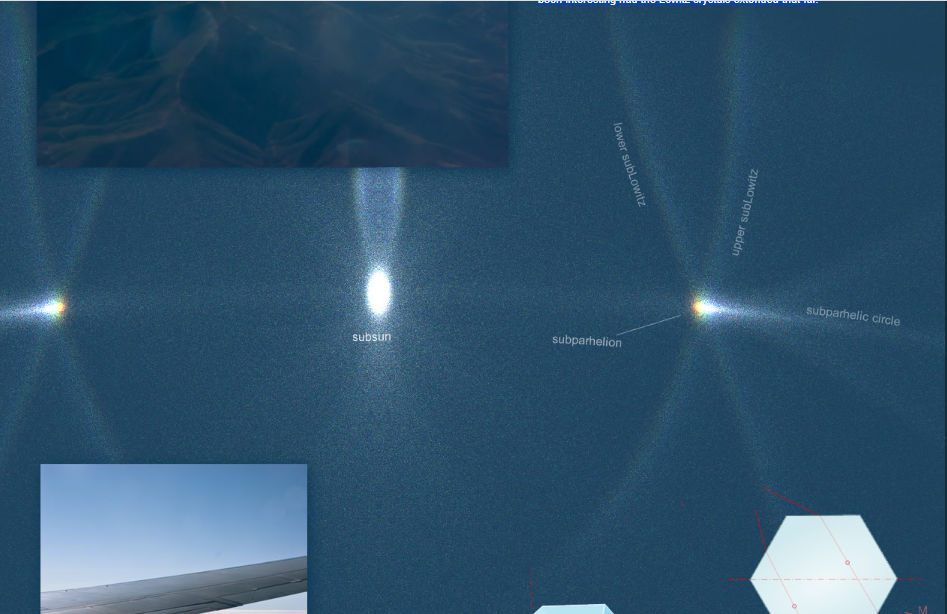OPOD - Subhorizon Lowitz Arcs
Subhorizon Lowitz Arcs: A Rare Atmospheric Phenomenon
Have you ever witnessed a breathtaking atmospheric phenomenon that left you in awe? Erica Damen experienced just that while flying over Spain. On her flight from Rotterdam, Netherlands to Faro, Portugal, she noticed some clouds appearing in the distance. As the plane approached, a portion of the cloud seemed to break and fall down, resembling faint smoke. Intuitively, Erica sensed that something extraordinary was about to happen. Moments later, the sun's rays illuminated these "faint fallen smoke clouds," creating a mesmerizing sight. Little did she know, she had witnessed a rare occurrence known as subhorizon Lowitz arcs.
Unraveling the Mystery of Subhorizon Lowitz Arcs
Subhorizon Lowitz arcs are a captivating optical phenomenon that can be observed in the Earth's atmosphere. Unlike other atmospheric optical phenomena that are reflections or refractions of light, subhorizon Lowitz arcs are produced by an additional ray reflection inside ice crystals. These ice crystals act as tiny prisms, bending and reflecting sunlight in unique ways.
The most remarkable feature of subhorizon Lowitz arcs is their formation in conjunction with a subparhelion. A subparhelion is a bright and colorful halo that appears 22° or more away from the subsun. It is caused by an odd number of reflections inside horizontal plate ice crystals. Tailing away from the subparhelion, one can observe a fragment of the subparhelic circle.
The Rarity of Subhorizon Lowitz Arcs
Witnessing subhorizon Lowitz arcs is an extraordinary event. In fact, the existence of Lowitz arcs itself was doubted until approximately 20 years ago. To see these elusive arcs below the horizon adds an extra layer of wonder to the experience. The combination of the subparhelion, subhorizon Lowitz arcs, and the fragment of the subparhelic circle forms a cross-like pattern, creating a truly magnificent sight.
To understand the conditions required for the formation of subhorizon Lowitz arcs, we can examine Erica Damen's observation. The sun's altitude during her flight was approximately 30°, and a HaloSim ray tracing simulation was conducted using thick Lowitz-oriented plates and a few horizontal plates. The simulation showed a reasonable match with the observed phenomenon, but it required a very high concentration of ice crystals. It is worth noting that Lowitz arc production is highly inefficient, making the presence of such arcs even more remarkable.
Exploring the Potential of Subhorizon Lowitz Arcs
Although Erica Damen's observation provided a glimpse into the beauty of subhorizon Lowitz arcs, one can't help but wonder what lies beyond the subsun. If the Lowitz crystals extended further, the area above the subsun would have been equally intriguing. This opens up avenues for further exploration and research into the behavior and characteristics of these elusive atmospheric phenomena.
In conclusion, witnessing subhorizon Lowitz arcs is a rare and captivating experience. These arcs, formed by an additional ray reflection inside ice crystals, create a stunning visual display when combined with a subparhelion and the fragment of the subparhelic circle. The rarity and inefficiency of Lowitz arc production make these phenomena all the more mesmerizing. As we continue to unravel the mysteries of atmospheric optics, occurrences like subhorizon Lowitz arcs remind us of the beauty and complexity that exist above us in the ever-changing sky.

Sub-Horizon Lowitz Arcs?
Erica Damen saw this rare sight looking down towards the ground somewhere over Spain.
“I flew on September 20, 2011 from Rotterdam in the Netherlands to Faro in Portugal. And of course I was looking outside all the time. It was very clear most of the flight but at one time I saw some clouds appearing far away. When the plane flew nearer there was a part of the cloud slowly breaking and falling down, like as though it was faint smoke. My intuition told me that there was something extraordinary going to happen...but really...I don't know why! Then the plane took a turn to the left and the sun was shining on these "faint fallen smoke clouds" for some time with this beautiful sighting as a result!"
The bright colourful halo is a subparhelion and tailing away from it to the right is a fragment of the subparhelic circle. Sub horizon arcs are not reflections of those above the horizon nor generated from the usually intensely bright subsun. They are produced from direct sun rays by an additional ray reflection inside each ice crystal. The subparhelion is 22° or more from the subsun and the result of an odd number of reflections inside horizontal plate crystals.
The really great rarities are the two coloured arcs forming a cross through the subparhelion. These are very likely subhorizon Lowitz arcs. It is wonderful enough to see Lowitz arcs, their existence doubted until some 20 years ago – but to see subhorizon Lowitz! The remainder of the trip would be seriously anticlimactic.
The sun altitude was roughly 30° and a HaloSim ray tracing for rather thick Lowitz oriented plates and a few horizontal plates is below. The match is reasonable, although a very high concentration of crystals was necessary. Lowitz arc production is very inefficient. The area above the subsun would have been interesting had the Lowitz crystals extended that far.



Note: this article has been automatically converted from the old site and may not appear as intended. You can find the original article here.
Reference Atmospheric Optics
If you use any of the definitions, information, or data presented on Atmospheric Optics, please copy the link or reference below to properly credit us as the reference source. Thank you!
-
<a href="https://atoptics.co.uk/blog/opod-subhorizon-lowitz-arcs/">OPOD - Subhorizon Lowitz Arcs</a>
-
"OPOD - Subhorizon Lowitz Arcs". Atmospheric Optics. Accessed on November 15, 2024. https://atoptics.co.uk/blog/opod-subhorizon-lowitz-arcs/.
-
"OPOD - Subhorizon Lowitz Arcs". Atmospheric Optics, https://atoptics.co.uk/blog/opod-subhorizon-lowitz-arcs/. Accessed 15 November, 2024
-
OPOD - Subhorizon Lowitz Arcs. Atmospheric Optics. Retrieved from https://atoptics.co.uk/blog/opod-subhorizon-lowitz-arcs/.